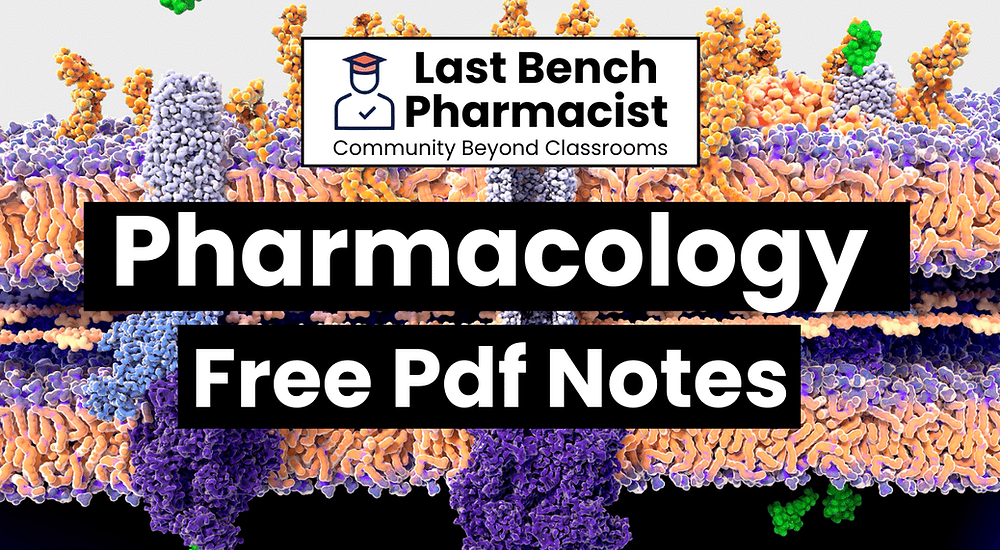



#bpharmnotes #bpharmpharmacology2notes #bpharmpdfnotes
Welcome, Last Bench Pharmacist, to the captivating realm of B. Pharm Pharmacology, where you’ll embark on a thrilling journey to unlock the secrets of how drugs interact with our bodies to elicit therapeutic effects. Prepare to witness the awe-inspiring dance between molecules and cells, as you learn how medications combat diseases, alleviate symptoms, and ultimately improve lives! Feeling lost in the maze of receptors, neurotransmitters, and drug mechanisms? Fear not, for I have crafted a potent elixir – comprehensive B. Pharm Pharmacology PDF notes, enriched with illuminating visuals, ready to guide you through this enlightening exploration!
Scope:
The main purpose of the subject is to understand what drugs do to the living organisms and how their effects can be applied to therapeutics. The subject covers the information about the drugs like, mechanism of action, physiological and biochemical effects (pharmacodynamics) as well as absorption, distribution, metabolism and excretion (pharmacokinetics) along with the adverse effects, clinical uses, interactions, doses, contraindications and routes of administration of different classes of drugs.
Objectives: Upon completion of the subject student shall be able to:
Understand the pharmacological actions of different categories of drugs
Explain the mechanism of drug action at organ system/sub cellular/ macromolecular levels.
Apply the basic pharmacological knowledge in the prevention and treatment of various diseases.
Observe the effect of drugs on animals by simulated experiments
Appreciate correlation of pharmacology with other bio medical sciences
Introduction to Pharmacology- Definition, historical landmarks and scope of pharmacology, nature and source of drugs, essential drugs concept and routes of drug administration, Agonists, antagonists( competitive and non competitive), spare receptors, addiction, tolerance, dependence, tachyphylaxis, idiosyncrasy, allergy.
Pharmacokinetics- Membrane transport, absorption, distribution, metabolism and excretion of drugs .Enzyme induction, enzyme inhibition, kinetics of elimination
a. Pharmacodynamics- Principles and mechanisms of drug action. Receptor theories and classification of receptors, regulation of receptors. drug receptors interactions signal transduction mechanisms, G-protein–coupled receptors, ion channel receptor, transmembrane enzyme linked receptors, transmembrane JAK-STAT binding receptor and receptors that regulate transcription factors, dose response relationship, therapeutic index, combined effects of drugs and factors modifying drug action.
b. Adverse drug reactions.
c. Drug interactions (pharmacokinetic and pharmacodynamic)
d. Drug discovery and clinical evaluation of new drugs -Drug discovery phase, preclinical evaluation phase, clinical trial phase, phases of clinical trials and pharmacovigilance.
a. Organization and function of ANS.
b. Neurohumoral transmission, co-transmission and classification of neurotransmitters.
c. Parasympathomimetic, Parasympatholytics, Sympathomimetics, sympatholytic.
d. Neuromuscular blocking agents and skeletal muscle relaxants (peripheral).
e. Local anesthetic agents.
f. Drugs used in myasthenia gravis and glaucoma
a. Neurohumoral transmission in the C.N.S. Special emphasis on importance of various neurotransmitters like with GABA, Glutamate, Glycine, serotonin, dopamine.
b. General anesthetics and pre-anesthetics.
c. Sedatives, hypnotics and centrally acting muscle relaxants.
d. Anti-epileptics e. Alcohols and disulfiram
a. Psychopharmacological agents: Antipsychotics, antidepressants, anti-anxiety agents, anti-manics and hallucinogens.
b. Drugs used in Parkinsons disease and Alzheimer’s disease.
c. CNS stimulants and nootropics.
d. Opioid analgesics and antagonists
e. Drug addiction, drug abuse, tolerance and dependence.